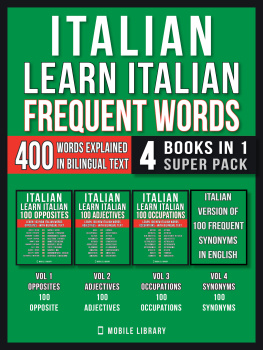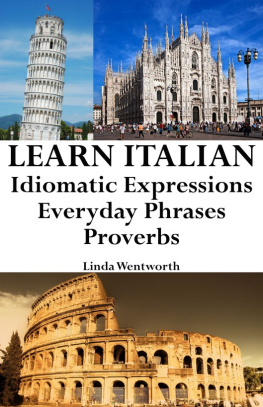Italian Reform and English Reformations, c.1535c.1585
In loving memory of Alan Overell
Italian Reform and English Reformations, c.1535c.1585
ANNE OVERELL
The Open University, UK
First published 2008 by Ashgate Publishing
Published 2016 by Routledge
2 Park Square, Milton Park, Abingdon, Oxon OX14 4RN
711 Third Avenue, New York, NY 10017, USA
Routledge is an imprint of the Taylor & Francis Group, an informa business
Copyright 2008 Anne Overell
Anne Overell has asserted her moral right under the Copyright, Designs and Patents Act, 1988, to be identified as the author of this work.
All rights reserved. No part of this book may be reprinted or reproduced or utilised in any form or by any electronic, mechanical, or other means, now known or hereafter invented, including photocopying and recording, or in any information storage or retrieval system, without permission in writing from the publishers.
Notice:
Product or corporate names may be trademarks or registered trademarks, and are used only for identification and explanation without intent to infringe.
British Library Cataloguing in Publication Data
Overell, M. Anne
Italian Reform and English Reformations, c.1535c.1585. (Catholic Christendom, 13001700)
1. Reformation England 2. Reformation Italy 3. England Relations Italy 4. Italy Relations England
I. Title
274.206
Library of Congress Cataloging-in-Publication Data
Overell, M. Anne.
Italian Reform and English Reformations, c.1535c.1585 / by M. Anne Overell.
p. cm. (Catholic Christendom, 13001700)
Includes bibliographical references and index.
ISBN 978-0-7546-5579-4 (alk. paper)
1. ReformationEngland. 2. ReformationItalyInfluence. 3. EnglandRelationsItaly. 4. ItalyRelationsEngland. I. Title.
BR375.O94 2008
274.206dc22
2007050604
ISBN 978-0-7546-5579-4 (hbk)
ISBN 978-1-3155-9021-9 (ebk)
Contents
Series Editors Preface
The still-usual emphasis on medieval (or Catholic) and reformation (or Protestant) religious history has meant neglect of the middle ground, both chronological and ideological. As a result, continuities between the middle ages and early modern Europe have been overlooked in favor of emphasis on radical discontinuities. Further, especially in the later period, the identification of reformation with various kinds of Protestantism means that the vitality and creativity of the established church, whether in its Roman or local manifestations, has been left out of account. In the last few years, an upsurge of interest in the history of traditional (or catholic) religion makes these inadequacies in received scholarship even more glaring and in need of systematic correction. The series will attempt this by covering all varieties of religious behavior, broadly interpreted, not just (or even especially) traditional institutional and doctrinal church history. It will to the maximum degree possible be interdisciplinary, comparative and global, as well as non-confessional. The goal is to understand religion, primarily of the Catholic variety, as a broadly human phenomenon, rather than as a privileged mode of access to superhuman realms, even implicitly.
The period covered, 13001700, embraces the moment which saw an almost complete transformation of the place of religion in the life of Europeans, whether considered as a system of beliefs, as an institution, or as a set of social and cultural practices. In 1300, vast numbers of Europeans, from the pope down, fully expected Jesuss return and the beginning of His reign on earth. By 1700, very few Europeans, of whatever level of education, would have subscribed to such chiliastic beliefs. Pierre Bayles notorious sarcasms about signs and portents are not idiosyncratic. Likewise, in 1300 the vast majority of Europeans probably regarded the pope as their spiritual head; the institution he headed was probably the most tightly integrated and effective bureaucracy in Europe. Most Europeans were at least nominally Christian, and the pope had at least nominal knowledge of that fact. The papacy, as an institution, played a central role in high politics, and the clergy in general formed an integral part of most governments, whether central or local. By 1700, Europe was divided into a myriad of different religious allegiances, and even those areas officially subordinate to the pope were both more nominally Catholic in belief (despite colossal efforts at imposing uniformity) and also in allegiance than they had been four hundred years earlier. The pope had become only one political factor, and not one of the first rank. The clergy, for its part, had virtually disappeared from secular governments as well as losing much of its local authority. The stage was set for the Enlightenment.
Thomas F. Mayer,
Augustana College
Acknowledgements
As a latecomer to the community of sixteenth-century historians, I have found friendship and generosity beyond all expectation. Behind the list of names that follows are the well-timed moments of encouragement, informative emails and tactful criticisms that made this book possible. So, I record my inadequate thanks: to John McDiarmid, whose scholarly comments on several chapters were invaluable; to Susan Doran and Tom Freeman, who have most generously read and reacted to whole chapters; also to Margaret Aston, Kenneth Austin, Susan Brigden, Ruth Chavasse, Elizabeth Evenden, Dermot Fenlon, Bruce Gordon, Peter Marshall, Charlotte Methuen, Letizia Panizza, Patrick Preston, Alex Ryrie, Bill and Sarah Sheils, David and Pamela Selwyn, Tracey Sowerby, Mark Taplin, Alexandra Walsham and Michael Williams for their painstaking and imaginative aid. The text that follows did not grow directly out of a thesis, but Diarmaid MacCulloch, Ole Grell and Jonathan Woolfson, examiners for my doctorate by published work, gave so much practical and generous help that a book began to seem achievable. I thank all my colleagues for helping more than they know: of course, mistakes will remain and they are mine alone.
At various stages on my career path Rosemary ODay, Penry Williams and Anthony Wright were wise and witty teachers and supervisors. Tom Mayer is a most affirmative series editor: I cannot count the number of times I have drawn on his immense knowledge. I have also benefited much from the editorial wisdom and friendly guidance of Tom Gray and Ann Allen of Ashgate. My thanks are due to many librarians in Britain and Italy, but especially to the staff of the Brotherton Library at the University of Leeds, the Open University Library and the Archivio di Stato in Mantua. Research travel to Italy has been supported for several years by the Open University and I record my gratitude. Annamaria Basile, Antonella Cavazza, Chiara La Sala, Lara Mocellin and Federica Sulas helped with language, translation, transcription and warm hospitality; Timothy Jarrold offered careful reading and many insights. I am also very grateful indeed to all my friends for tolerating me and my strange subject; Jane Hunts constant support and Ailsa Swarbricks encouragement and eagle eye were truly indispensable. Last, I record my loving thanks to my family: its four very young members are a perfect diversion, whilst the adults, Stephen and Olive, James and Helen, and Jan, all found time in their busy lives to read, question, comment and care about the progress of this book. I dedicate it to the memory of my husband, Alan Overell: he once said that history was for the enhancement of life and I think he was right.








